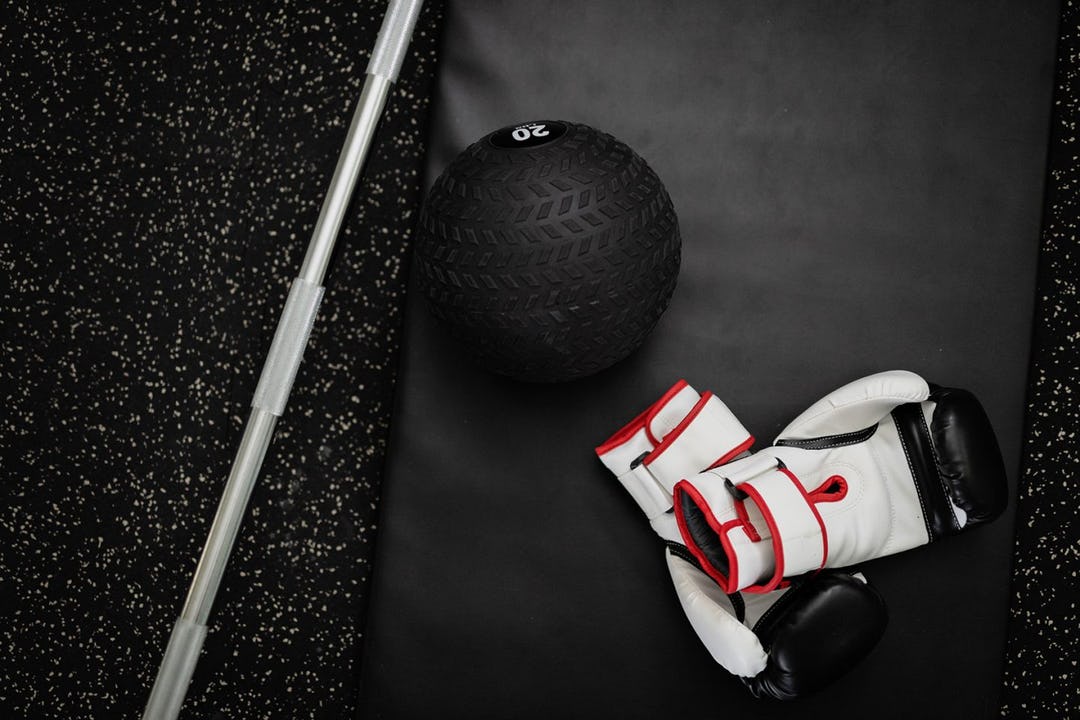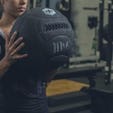Medicine balls aren’t just one of the most versatile tools in the gym, they’re also perhaps the oldest, long predating even the idea of a gym itself. Med balls have been part of strength and fitness culture for thousands of years, dating back to when the famed ancient Greek physician Hippocrates allegedly had his patients toss stuffed animal skins for “medicinal” purposes.
Everyone from PE students to elite athletes can safely use a weighted ball to get a variety of training effects, including power, strength, and stability, and the medicine ball can let you move and express force in ways that aren’t practical or even possible with dumbbells, kettlebells, or any other implement. It’s also great for taking your training outside on a warm day (always a nice change from a dank, dark, and musty gym). Here’s what you need to know to get in great shape using medicine balls, including a sample fat-burning and conditioning workout from an Onnit Master Trainer.
Benefits of Using a Medicine Ball in Your Workout

The medicine balls you’ll find in most gyms range from just a few pounds to around 20, so, clearly, trying to use one to build maximum strength would be chasing the wrong ball. But that doesn’t mean med ball training isn’t bad ass. It’s easy for a beginner to see the limited loading potential of the medicine ball as a drawback, but it’s really an asset. “Medicine balls are best for developing power along with strength,” says Juan Leija, General Manager of Onnit Gym in Austin, TX. That is, they help train you to explode, so you can use the muscle strength you build with other types of equipment in a way that translates to better athletic and real-world performance.
As with practically any other type of ball, the medicine ball is designed to be thrown. And just as you can’t throw a big, heavy rock very fast or far, a modestly-weighted medicine ball is going to let you generate a lot more power than a heavy dumbbell/barbell/kettlebell will (and yeah, it will also land more softly and safely, too). But if medicine balls are so great for power development, then what are the Olympic lifts—power cleans and snatches—good for?
Clean and snatch variants can certainly build power, but they’re difficult to learn and are risky to perform—especially for older exercisers, or those who don’t have a background in them. Trying to do explosive exercises with a barbell also doesn’t let you produce the maximum amount of force, because you must decelerate the bar at the end of the range of motion (otherwise, it will fly out of your hands). You literally have to put the brakes on. Throwing a med ball, on the other hand, allows you to let go—of the ball, and the braking mechanism that limits your power.
Furthermore, the medicine ball lets you express power in different movement paths than you have access to with Olympic lifts. Specifically, you can take advantage of rotation, which conventional lifting practically ignores.
“If someone is starting off with med ball training, I like having them do med ball slams,” says Leija, lifting the ball overhead and then smashing it into the ground with a downward throw. “I also have clients do some kind of rotational work—maybe a rotating punching motion, or tossing the ball into a wall that you’re not going to make a hole in.” Exercises like this can help develop better throwing and punching power, if you’re an athlete or martial artist, but Leija says they’re also a great choice for anyone to use near the start of a workout to prepare the central nervous system (CNS). Explosive movements sharpen the CNS’ ability to recruit muscle fibers, and they can actually help you feel more alert and focused for the session ahead. Try two to three sets of three to five reps after you’ve warmed up, and before you do any full-body or upper-body lifting.
The flip side to developing explosiveness is the ability to absorb and redirect force, an important skill for any athlete. In other words, medicine balls can train your body to dish it out, but they can also train you to take it. Throw the ball to a partner and have him/her throw it back to you (or throw it against a wall so it bounces back) and catch it. From there, you can toss the ball back, in another direction, or slam it down. If this sounds similar to how you move during a basketball or football game, you’re starting to see how med balls can improve your athleticism.
Sometimes you don’t even have to lift a medicine ball at all to get some use out of it. It can act as an unstable surface that you balance on. Doing pushups with one or both hands on a ball (or balls) can make your rotator cuff muscles work harder, helping to strengthen your shoulders and prevent injury. You can put your heels on one or more balls and do glute bridges or hamstring curls to build stability in the hips and core.
“Medicine balls are great for exploring movement,” says Leija. Unlike machines, which choose your path of movement for you, medicine balls lifts—throws, chopping motions, rotations, etc.—let you move in big, arcing, three-dimensional ranges that your body is free to explore safely. There’s virtually no free-weight exercise that you wouldn’t risk injury on if your form slips a little bit, but thanks to the light weight, breaking form on medicine ball exercises isn’t especially dangerous. In fact, it can even be advantageous. “No lift is ever going to be perfect,” says Leija. “Every med ball rep you do is going to be a little different—just like when you pick up a box off the ground, it’s never perfectly balanced.” Medicine ball training prepares your body for the asymmetries and instabilities of real-world activity, so, Leija says, “it gives you a functional kind of fitness training.”
Do Medicine Balls Help you Lose Weight?
Busting out a well-designed med ball circuit two to three times a week (scroll down for an example), or working some athletic medicine ball exercises into your program can help you shed some body fat, but don’t count on this medicine being the only prescription you need to be healthy. Any kind of exercise regimen has to go hand-in-hand with dietary changes if you want to get leaner.
“The problem with simply using exercise to lose weight is that even the longest, sweatiest workouts only burn a few hundred calories,” explains nutritionist, powerlifter, and competitive kickboxer Paul Salter, RD (thepaulsalter.com). “If sustainable long-term fat-loss is your goal, then eating less—and eating better—is the only way to make it happen.”
What Muscles are Used with Medicine Balls?

The most popular medicine ball movements all place great demands on the muscles of the core, including not only the rectus abdominis, or “six-pack” muscle, but also the obliques and the deep core muscles like the transversus abdominis. Not sure where these muscles are? Do some rotational movements like side tosses, punch-throws, or simply tossing around a med ball with a partner, and you’ll feel them the next day.
But another upside to medicine ball training is that it demands that a wide range of muscles work together, and that makes you a more coordinated, more powerful athlete overall. An overhead medicine ball slam, for instance, uses not only the muscles of the core, but also the hips, lats, shoulders, and even the calves and arms—all in a movement that takes about a second to perform.
In the case of movements where you hold a medicine ball in front of your torso, like cleans, punches, squats, wall balls, or lateral lunges, the postural muscles of the upper back will also get a sneakily hard workout just from keeping you upright while in a range of positions. This is especially true of exercises done with heavier medicine balls, such as cleans that simulate picking up an Atlas stone (a strongman exercise).
Medicine Ball Exercises
The following moves are Leija’s picks for trainees that are new to medicine ball work. They can be performed for reps, or time (for instance, do as many reps as you can in a minute). If you want to maximize power output, choose a 5–12-pound ball and keep your reps under 10 to focus on moving the ball as fast as possible. Rest as needed between sets to ensure recovery. To get more of a calorie-burning, endurance-boosting effect, string some exercises together as a circuit and perform them for higher reps.
All exercises demonstrated by Juan Leija.
1. Medicine Ball Slam
The slam is a full-body expression of power unlike anything else you’re allowed to do in a commercial gym, and it can work equally well as a CNS-priming warmup, an explosive power-boosting drill, or part of a conditioning circuit. (Just watch that rebound so you don’t catch a ball to the grill. It happens more often than you think.)
“The slam is actually a great way to work on hip hinge mechanics as well,” Leija says. “A lot of people think it’s all in the arms, but the power comes from the hips. Make sure that core is engaged, get your hips back, and generate power from there.”
Directions
Step 1. Stand with feet shoulder-width apart and hold the medicine ball with both hands in front of your chest.
Step 2. Raise the ball overhead, bending the elbows as you come up. Keep your ribs pulled down and your pelvis level with the floor by bracing your abs. You may come up on your toes as you reach to gather momentum.
Step 3. Explosively reverse the movement, bending your hips back while keeping your spine long. Slam the ball into the floor between your feet, and catch it on the rebound. Use the momentum of the ball rising to begin the next rep.
Tip: throw the ball like you mean it, with as much force as possible. “One of my favorite cues is to slam the ball like someone pissed you off,” Leija says. “For some reason, that always works.”
2. Medicine Ball Russian Twist
Twisting exercises train rotation, a much neglected movement pattern that’s essential for power development and overall stability. They can be awkward to perform with most other training implements, but the medicine ball makes them feel as natural as passing a basketball.
Directions
Step 1. Sit on the floor and hold the medicine ball between your hands in front of your chest. Raise your torso and legs into a low V shape, keeping the knees bent and heels slightly off the floor.
Step 2. Twist your torso from side to side, tapping the ball to the floor on each side. Keep your eyes pointed forward, and squeeze the ball between your hands throughout the motion.
Tip: You can bend your arms more to make the exercise less challenging, and extend them fully to make it harder. “And try to keep your feet from moving all over the place,” says Leija. “That will help keep the core engaged.”
3. Medicine Ball Pushup
The addition of a ball can make an already excellent strength exercise even better. Your chest, tris, and abs will all work harder, and, as an added bonus, you may find that gripping the ball is easier on your wrists than doing pushups on the floor. The conventional pushup position shoves the wrists back into extension, which can lead to pain and injury.
Directions
Step 1. Place your hands in a neutral (palms facing in) position on the top half of the medicine ball. Point your fingers toward the ground and grip the ball hard. Extend your legs behind you and set your feet between hip and shoulder width. Tuck your pelvis slightly and brace your core, so your body forms a long, straight line, from your head to your heels.
Step 2. Lower your body until your chest touches the ball. Try to squeeze the ball throughout each rep to limit instability and maximize tension on the chest muscles.
Advanced variation: Medicine Ball Alternating Pushup
Placing one hand on the ball for pushups increases the stability challenge, and helps you identify which side is weaker. This is a smart “level 2” to step up to when regular pushups start feeling easy. It can also work as a step toward mastering the one-arm pushup.
Directions
Step 1. Place one hand on top of the medicine ball and the other on the floor approximately shoulder-width away from the ball. Set your feet at about shoulder-width and get into a pushup position.
Step 2. Perform a pushup, lowering your torso until your chest is about level with the ball. As you press back up, switch hands on the ball and step your feet laterally to the other side of the ball.
Step 3. Perform another pushup on the other side of the ball.
Tip: Don’t attempt plyo pushups too soon. “Lots of people try to do explosive pushup variations using a med ball right away, but their regular pushups are kinda iffy,” Leija says. “I like to make sure they own the pushup on top of the ball before we progress to anything more complicated, like moving side to side.”
4. Medicine Ball Clean
We already explained why a light medicine ball is a great training tool, but a heavy one can be as well. Some medicine balls (such as the ProSourceFit Tread Slam Ball, shown here) weigh between 50 and 200 pounds or more to help simulate strongman training and present a harder challenge for grip strength and conditioning. The closer the ball’s weight gets to triple digits, the more you have to hug the ball to control it, so doing cleans with a heavy ball is an awesome full-body exercise.
But no matter the weight you use, lifting a ball from the floor to shoulder level places immense demands on the hips, grip, core, and upper back. After you’ve cleaned the ball, you can press it, carry it, or toss it back down and clean it again—all movements Leija says he has used to great effect with athletes.
Directions
Step 1. Place the med ball on the floor and stand behind it with your feet just outside shoulder width. Turn your toes out slightly.
Step 2. Hinge your hips back, keeping your spine as neutral as possible, and grasp the bottom half of the ball.
Step 3. Keeping your spine long and your lower back flat, use your legs and hips to power the ball off the floor and up to your chest. If it is a light ball, you can clean it to chest level in a single motion. A heavier ball may require you to rest it on your legs momentarily, reposition your hands, and hug it to lift it, or, you can lift it a few inches, and re-grip it in mid air, as Leija does here. Once you’ve got the ball up, drop it back to the floor between your feet.
Tip: “Picking up a ball from the ground requires kind of a squatty deadlift motion,” says Leija, “so think of it like a hinge: really engage the core, and drive power through the floor using your hips. Then, just get the ball up!”
5. Medicine Ball Skater Lunge
Lateral jumps are a staple movement in Leija’s training arsenal, he says, and he always likes to start athletes off with an unweighted version. But once they can do it properly, Leija likes to add a medicine ball to the movement, held in front of the chest.
The ball not only adds extra resistance, it intensifies the need for stability and reaction time. Skater lunges are excellent for athletes who have to corner or change directions quickly in their sport, but they can help anyone learn to control his/her body in motion, as well as coordinate multiple muscle groups in multiple planes of motion at once.
Directions
Step 1. Hold a medicine ball in front of your chest with feet around shoulder width. Lift one leg and hop to that side, landing farther than shoulder-width away. Let the medicine ball cross your body, and allow your rear leg to drift behind your front leg. Make the landing soft.
Step 2. Use the rebound effect to help you spring back to the other leg. You should look like an ice skater pushing off his/her leg to propel forward.
Tip: “Don’t keep the ball too close to your body,” Leija says. “Hold it out in front of you with your arms somewhat extended.” Not only will this make both the core and the postural muscles of the upper back work harder, it will also allow you to squat slightly deeper into the working leg and rebound more powerfully.
6. Medicine Ball Burpee Slam
This is one case where the weighted version of a movement is actually better and safer than the more popular bodyweight version. The reason is one that’s clear to anyone who has ever winced while watching an exhausted group class gut out burpees when they were running on fumes.
“That pushup position can get pretty shady for a lot of people,” says Leija. Not only does form degrade with fatigue, leading to sloppy, ineffective pushups at the bottom of each burpee, but repeatedly jumping the legs back and landing hard on the wrists is asking for injury. The squat form people typically use to lower themselves close to the floor is no picnic either. Most folks will round their lower backs, setting up a low-back injury.
“With the ball, you don’t have to go all the way to the ground,” says Leija. “You have something that keeps you a little higher.” The range of motion may be shorter, but the exercise is much easier on the joints—even when you’re smoked and having trouble keeping form. The med ball burpee slam is also just a great way to keep it spicy in the gym. “It makes people feel good that they can do something that looks cool,” says Leija, “but is also pretty effective.”
Directions
Step 1. Place the medicine ball on the floor and stand behind it with feet shoulder width. Squat down and squeeze the sides of the ball while you jump your feet out behind you and land in the top position of a pushup.
Step 2. Perform a pushup on the ball, and then jump your feet back up to the sides of the ball. In a single motion, lift the ball overhead while keeping a long spine and flat back, and then slam it to the floor. That’s one rep.
Tip: Don’t come crashing down onto that ball, or you might find yourself facedown on it! “When people are coming down, they have to really focus,” Leija says. “They’re like, ‘Oh, I’ve got to land on that ball and make sure I control it before I drop down to my chest.’”
Full-Body Medicine Ball Workout
Perform this workout one to three times per week, either at the start or end of your regular workout, or on a separate day that you want to spend focusing on power and conditioning. (Do not perform it two days in a row.) Alternate sets of the clean and pushup, resting as needed between sets until all sets are completed.
1. Medicine Ball Slam
Sets: 1 Reps: 5–7
2A. Medicine Ball Clean
Sets: 3–5 Reps: 3–8 reps
2B. Medicine Ball Pushup
Sets: 3–5 Reps: 10–12
EMOM Circuit
Finish the workout with the following circuit. Start a timer and begin the Russian twist at 00:00. Do the prescribed reps on each side, and then rest for as much time as is left before the start of the next minute (01:00).
Go on to the burpee slam and perform it the same way, resting until the timer is at 02:00. Then go on to the skater lunge, and rest until 03:00.
Repeat the process until 15 minutes is up.
1. Med Ball Russian Twist
Reps: 20 (each side)
2. Med Ball Burpee Slam
Reps: 5
3. Med Ball Skater Lunge
Reps: 10 (each side)
Follow Leija on Instagram, @juannit_247.

)






